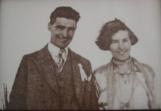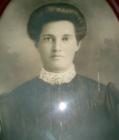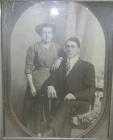1
While the communities on the French Shore of Newfoundland were not allowed to be permanently settled until 1904 there were some people who dared to defy the British Law by staying and settling overwinter in some of the harbours and coves along the rugged coast line.The first record of Conche being permanently settled is in 1816. A man by the name of James Herbert Dower came here from England with his crew on a ship called the Urdu. Some of the crew members included William Symmonds, Henry Bromley, Alexander Pynn, Timothy Saxton, John Downey, James Hope and Morris D'La Poer. They decided to stay and settle into Conche Harbour. They returned to their homeland the following spring, picked up their families and once again set sail for the French Shore of Newfoundland. By 1857 they had built a thriving community as the photographer Paul-Emile Miot proves by his photographs which are held at the National Archives in Ottawa.
The first settlers made their living from the sea and the land. They worked and lived side by side with the French fishermen and local history tells us that it was a harmonious period in the history of Conche. The French Navy hired Guardians to protect their premises when they returned to France in the winter months and it was those first settlers which they hired. The list is as follows: James Dower was the Guardian of Conche Harbour. Morris D'La Poer became the Guardian of Cape Rouge.
Alexander Pynn became the Guardian of Northeast Cape Rouge. Henry Bromley became the Guardian of Fishot Isle and James Hope became the Guardian in Croc.
In 1852 John Dower, the son of James Herbert, was the Guardian of Conche Harbour when he was granted a silver medal by the French Ministry for the Marine and the Colonies. In 1860 he saved the lives of several French fishermen in Conche harbour. Once again he was awarded a gold medal for his bravery. Documents accompanying the medals read as follows:
Minister for the Marine and the Colonies
The Minister and Secretary of State
For the Navy
And Colonies
Certifies that by an order dated December 23, 1852
H.M. the emperor granted a 1st class silver medal of honour
To Mr. John Doure, English subject, guardian of the harbour of Conche
In Newfoundland, in recognition of the many services rendered by him to the French navy.
Paris, May 24, 1853
______Theodore Duoos*______________
By the minister:
The Director of Personnel
(sign of the Imperial Eagle, under
the reign of Napoleon Bonaparte III)
Imperial Navy
The Minister and Secretary of State for the department of
The Navy and Colonies
Certifies that by an order dated December 12, 1860
The Emperor awarded a medal of honour
In gold to Mr. John Dower, guardian of the harbour of Conche,
For having saved three French seamen who where in danger of
Drowning on June 24, 1860
Paris, February 26, 1861
(de Challeloup-Laubat)
by the Minister
the Director of Personnel
(signature)
These documents and medals are currently on display at the French Shore Interpretation Center in Conche, Newfoundland, Canada.
It was through the preservance of those men and their families that Conche became a thriving center along the coast of Newfoundland. They built a community based on respect for one another with beliefs in higher education, healthy living and social interaction.
2
Dan FitzGerald and Mary Ellen Woodford.In 1904, the French left the French Shore. It was Dan FitzGerald's father, Jack Fitzgerald, who came to Conche as the first English magistrate, sent by the Newfoundland Government that same year.
4
Elizabeth Brazil Hunt.It was common practice for young girls all over Newfoundland to travel to booming communities in search of employment. Many of the girls were hired as serving maids in homes within these thriving towns. Elizabeth Hunt was one such girl who travelled to Conche from Spaniards Bay, Newfoundland in the late 1800's. She went on to marry Henry Hunt, a direct descendent of John Hunt, who was one of the first settlers to come to Conche in the early 1800's.
6
Michael (Mike) SymmondsMike Symmonds was a direct descendent of William Symmonds who was one of first, original settlers to come to Conche from England in the early 1800's. The Symmonds were renowned for their expertise in carpentry and boat building. Mike left Conche as a young man in 1917 and moved to Boston, Massachusetts. Mike never returned. This was not an uncommon practice at the time, many a young man and woman left their homes in search of employment and adventure in United States.
8
Bridget Ellen CaseyBridget Ellen Griffin married William Casey, the son of Captain Tom Casey (1799-1880). Tom Casey was immortilized in one of the earliest extant ballads describing a Newfoundland sealing voyage. His ship's clock, parallel rule, chart case and navigational charts were held in the community until recently.
The French Shore Historical Society presently holds the deeds to two of the Casey premises.
The first building is a Casey fishing premises, built in 1904, the year which France relinquished her rights to the Treaty Shore of Newfoundland. As such, the Casey building shares an important anniversary with an event of great historical significance to this old French fishing station (Conche). The building is now recognized as a Provincial Heritage Structure known as Casey's Store. The other building, a residence, built in 1920, has been restored and is now known as the Casey House - Artist retreat.
10
Lucy Flynn and Pat BrothersLucy Flynn's great grandfather, Martin Flynn was a man that James Herbert Dower met in his travels and brought back to Conche. Martin Flynn was a mining engineer who knew minerals when he saw them. He puttered about the country looking for mines.
According to Evelyn Saxton Connor he found one, a copper mine in Green Bay, Newfoundland and a very good gold mine on the MacGrath property in St. Julian's, Newfoundland. Unfortunately the gold mine was never mined due to England's colonial restrictions of the time. Neither was Flynn awarded any renumeration or credit for discovering the copper mine in Green Bay, even though it resulted great wealth for the British.
Martin Flynn was half Irish and half French. His people had gone to the United States from France about the time that Lafayette went to America to help in the Revolution. Martin's French relatives were descendents of Irish who went into France at the time of the siege of Limerick, Ireland.
Ironically, Martin went on to marry James Herbert Dower's daughter Mary. Many of their descendents still reside in Conche today.




